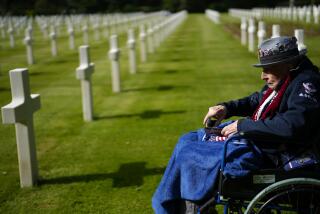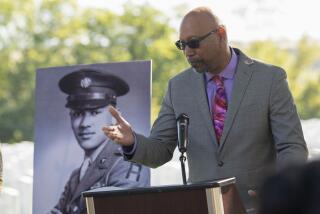Big Red One’s Veterans Will Get Special Salute
FT. RILEY, Kan. — Come this Fourth of July, the warriors of the 1st Infantry Division, the fabled Big Red One, will celebrate the nation’s birthday among family and friends and hospitable surroundings far from the din of battle and horrid sights of war.
Less than five months ago, the latest generation of the division broke through Iraqi defenses in Operation Desert Storm, the first troops to breach Saddam Hussein’s bulwarks and minefields.
It was apt that it was the 1st Division to blaze the path for others, since it was the first outfit to go overseas in World War I, the first American fighting force to reach France in World War II and the first Army division in Vietnam.
Home from its latest war in the Persian Gulf, the division will be honored at its home at Ft. Riley and in neighboring Junction City and Manhattan with parades and sundown salutes on America’s 205th birthday, its homecoming celebration.
The ceremonies will honor 1st Division veterans, from 91-year-olds Clinton Dattel and Max Ottenfeld to 19-year-old Raphael Crews.
This Independence Day stirs memories of another parade 74 years ago. On July 4, 1917, troops of the 1st Division’s predecessor, the 1st Expeditionary Division, marched to the adoration of the French along the boulevards of Paris to the tomb of Lafayette, the French nobleman who fought with the rebel colonies against the British in the War of Independence.
Two days later, the expeditionary force was redesignated the 1st Division. It included the 16th, 18th, 26th and 28th infantries and the 5th, 6th and 7th artillery, all handpicked by Gen. John J. Pershing, commander of the forces sent to Europe.
The only war the division missed this century was Korea, in the early 1950s, and only because it was on occupation duty in Germany after World War II.
The division is rich in tradition, its heritage as old as the America it protects. One of its units, Delta Battery, 1st Battalion, 5th Artillery, is the oldest in the Army, organized in March, 1775, by Alexander Hamilton.
Its feats are volumes of history, a roll call of 32 Medal of Honor recipients, America’s highest honor. More than 14,000 of its men and women fell on the battlefields that live on in history and in the minds of surviving old soldiers of the division who reunite once a year to perpetuate the legend.
Cantigny, Soissons, St. Mihiel, Meuse-Argonne of World War I; Normandy, Omaha Beach, the Battle of the Bulge, of World War II; the Iron Triangle, Bau Bang and the Michelin rubber plantations of Vietnam.
While it is a joyful homecoming for the warriors of Desert Storm, the loss of 17 comrades in arms is mourned. They will join the soldiers of other wars commemorated at the 1st Division Memorial in Washington.
“We had men who were dedicated,” says Max Ottenfeld, of Chicago, who enlisted in World War I right out of high school. He fought at St. Mihiel and Meuse-Argonne, was gassed by the Germans and suffered shellshock.
“They were proud of what they had accomplished,” Ottenfeld adds. “We were never withdrawn trying to make an advance. We made all our objectives.”
Clinton Dattel, of Southampton, Pa., was among the first volunteers for World War I.
“We broke through every battle,” he says. “We were the first ones to do the fighting and we did the first breakthrough of all the fronts. After we broke through, the other divisions would come in and hold the places that we conquered.”
Cantigny was the first victory of the war in May, 1918. In under an hour, the 28th Regiment, the “Black Lions of Cantigny,” captured the strategic town that sat on the high ground and served the Germans as an observation post.
In the summer of 1918, the division pushed 7 miles into German lines, capturing Soissons, but at a heavy cost--7,000 men killed and wounded, one-third the division’s casualties for the entire war. Victories at St. Mihiel and Meuse-Argonne followed in the fall, and by November the war was over.
“This was the first time on that scale and in those numbers the U.S. Army pulled together troops like that to form a division,” says Bill McKale, a historian at the 1st Division Museum in Ft. Riley, headquarters of the division.
It has been on continuous duty ever since and in August, 1942, it was again redesignated the 1st Infantry Division. Again in World War II and Vietnam, the division was the first into combat.
On D-day, June 6, 1944, the Big Red One spearheaded the biggest allied offensive of the war, the invasion of Normandy, the cataclysmic battle of World War II.
They assaulted the famous Omaha Beach under withering machine gun and artillery fire from German pillboxes atop a hill that commanded the landing area. They drove the Germans back and captured the beach in five days of fierce fighting that cost them 1,000 men.
“The whole invasion of Europe hung pretty much on that battle,” says Art Chaitt, the executive director of the Society of the First Division. After that, the division rolled through France and Belgium, crossed the German border and captured Aachen, the first major German city to fall to the Americans. Another first for the 1st Infantry Division.
Gino Merli, one of three surviving Medal of Honor winners in the division, says that the spirit of the division comes from its motto. It is engraved on a plaque at Ft. Riley dedicated to soldiers past, present and future:
“No mission too difficult,
No sacrifice too great,
Duty first!”
“When I joined the division as a recruit in England, their motto gave me the first inspiration of being one of the best soldiers fighting to support and defend patriotism,” says Merli, 67, of Peckville, Pa. The street on which he lives was renamed Gino Merli Drive in his honor.
But even more than that was the camaraderie and loyalty that compelled Merli to stay at his machine gun fending off scores of attacking Germans single-handedly near Sars La Bruyere in Belgium in September, 1944.
“When I landed on D-day, having witnessed many dead comrades, I was given further inspiration to fight for the buddies who were left lying dead on the beachhead,” Merli says. “When my assistant gunner was killed, that rose the adrenaline a thousand percent to fight the enemy to death, even though I faced death.”
While the men, weapons, tactics and training change, facing one’s mortality remains a constant for soldiers such as Raphael Crews.
Crews, of Orlando, Fla., was the lead tank driver when the division scored another first by breaching the Iraqi defenses.
“The night before I remember I was real nervous, real edgy and scared, but when it came down that morning and we had everybody lined up behind us I was pretty much excited,” Crews recalls. “I was still a little bit nervous but I was ready to go.
“I thought about home. I thought about my family, my little sister and pretty much, I guess it happens to everybody, a lot of things from your past pass through your life and a lot of hopes and desires you would like to fulfill go through your mind.”
For Crews, that was to play the guitar in a band.
Operation Desert Storm was the first battle test of the new all-volunteer Army. Many of the recruits, like Crews, joined for college money and benefits with little thought of going to war.
Like the rest of the military, the division’s darkest hour may well have been Vietnam, a war that many draftees didn’t want to fight. This was a war where, in the public’s eye, there were no heroes even though soldiers of the 1st Division won 11 Medals of Honor, all but two awarded posthumously.
“It all depends on your perspective,” says Antonio Maria, 47, of Maplewood, N.J., who was wounded in Vietnam. “Our perspective was there was a job to do regardless of what the politicians said. If the war was lost, it was not lost because of us. It was lost by the politicians and the war protesters.”
Vietnam critics questioned the strategy of massive search-and-destroy operations that produced too few results and too many American casualties. More than 3,000 1st Division troops died in Vietnam between 1965 and 1970.
After returning from Vietnam in 1970, the Big Red One was reorganized from a straight infantry unit to a mechanized outfit with more tanks and armored fighting vehicles. It was redesignated 1st Infantry Division (Mechanized).
Desert Storm was widely acclaimed for its 100-hour ground war that surprised the Iraqis with a flanking maneuver to their rear when they were expecting a frontal assault.
For the 1st Division, it marked another first, the first time that large-scale and detailed rehearsals were conducted for 38 days before the real assault.
“We had detailed satellite photography which gave us a good feel for what we could expect on the other side,” says Brian Zahn, 37, of Bottineau, N.D., operations officer of the division’s 5th Battalion, 16th Infantry, 1st Brigade. “We constructed those defenses exactly as we saw them. We went so far as to include the wire, the minefields and the trenches that we expected to run into.”
When the division made the real assault, “It was very close to what we expected,” Zahn says. “The only thing that came as a surprise is how quickly the Iraqis surrendered. They were outclassed. It’s as simple as that. Our soldiers were better, the training was better, the equipment was better.”
Later, Big Red One troops were witness to another historic event, the signing of the cease-fire agreement last March 3 at Safwan in southern Iraq, which the division secured.
Zahn says the 1st Division is probably recognized as one of the finest combat units this nation has ever sent to war.
“I don’t know if it’s luck of the draw or being at the right place at the right time,” he says. “It probably has something to do with tradition, history kind of perpetuating itself. Being part of an organization like this causes one to feel like he’s something special.”
Gen. Gordon Sullivan, the newly named Army chief of staff, commanded the division in 1988-89. His predecessor, Gen. Carl Vuono, also served in the division.
Now that the division’s fourth and shortest war is over, its place in national policy will be reassessed as well as that of the Army, which is scaling back. Its 3rd Brigade, based in Germany, is scheduled for deactivation this summer as part of the reduction of forces in Europe. It likely will be replaced with a reserve brigade.
But not to worry about the Big Red One.
“There will always be a 1st Infantry Division because of the history and tradition that division holds to the Army,” McKale, the historian, says. “If the 1st Division goes off the rolls, we won’t have an Army.”
More to Read
Sign up for Essential California
The most important California stories and recommendations in your inbox every morning.
You may occasionally receive promotional content from the Los Angeles Times.










